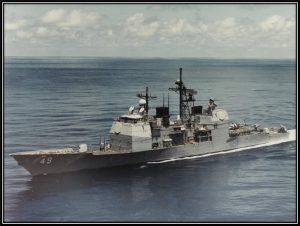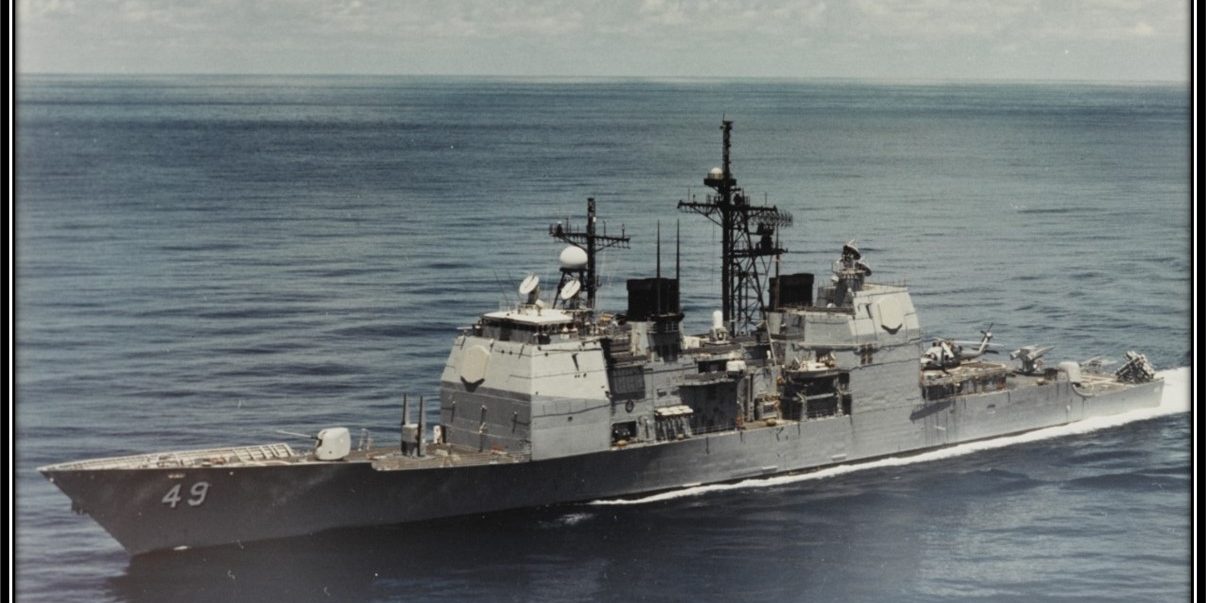Today in Aviation History: The USS Vincennes
Contributor: Barry Fetzer
Sources: Wikipedia, The Fog of War: USS Vincennes Tragedy
Aviation history includes some wonderful moments of success, joy, grit, and triumph, all events we should celebrate. Unfortunately, like life, aviation history also includes tragedies, horrible mistakes, overconfidence, and incomprehensible sadness.
And if we’re to be a truly great nation, we must be honest with and acknowledge our mistakes, be self-aware of our human failings, and admit to our constant attempts toward achieving that “more perfect Union” along with retaining the wise realization that while we’ll never achieve perfection, that irrefutable fact should also never cause us to cease trying.
Arguably one of US naval aviation’s worst mistakes occurred on this day in 1988 when, according to History.com, “In the Persian Gulf, the U.S. Navy cruiser Vincennes shot down an Iranian passenger jet that it mistook for a hostile Iranian fighter aircraft. Two missiles were fired from the American warship—the aircraft was hit, and all 290 people aboard were killed. The attack came near the end of the Iran-Iraq War, when U.S. vessels were in the gulf defending Kuwaiti oil tankers. Minutes before Iran Air Flight 655 was shot down, the Vincennes had engaged Iranian gunboats that shot at its helicopter.
“Iran called the downing of the aircraft a “barbaric massacre,” but U.S. officials defended the action, claiming that the aircraft was outside the commercial jet flight corridor, flying at only 7,800 feet, and was on a descent toward the Vincennes.
“However, one month later, U.S. authorities acknowledged that the airbus was in the commercial flight corridor, flying at 12,000 feet, and not descending. The U.S. Navy report blamed crew error caused by psychological stress on men who were in combat for the first time. In 1996, the U.S. agreed to pay $62 million in damages to the families of the Iranians killed in the attack.”
And according to the US Naval History and Heritage Command in a piece called The Fog of War: USS Vincennes Tragedy—3 July 1988 by Samuel J. Cox, Director NHHC July 2018, some details of the tragedy emerge:

USS Vincennes (CG-49), June 1986 (Courtesy Naval History and Heritage Command-NH 106519-KN)
“At 0947 on 3 July 1988, Iran Air Flight 655, an Airbus A300, took off 27 minutes late on a regularly scheduled flight (every Sunday and Tuesday from Bandar Abbas, a dual-use military and civilian airport) to Dubai— normally a short 30-minute flight. The pilot, Moshe Rezaian, was very experienced on this particular route. The flight was slightly off center, but still well-within the published flight corridor, Amber 59. Rezaian had no idea a surface action was going on directly under his flight path. Although Flight 655 was detected by Vincennes’s radar shortly after takeoff, the cruiser also detected a Mode II (military) identification, friend or foe (IFF) reading, most likely from an F-14 on the ground at Bandar Abbas. The operator mistakenly correlated the Mode II signal with the aircraft taking off rather than with the plane on the ground. The Aegis detected Flight 655’s Mode III (civilian) IFF transponder soon after take-off, but Vincennes’s anti-air warfare coordinator accepted the Mode II correlation as valid since Iranian military aircraft were known to transmit both Mode II and Mode III IFF. Just to be sure, the anti-air warfare coordinator had a sailor check the published flight schedule, and was told there was none (this was partly due to darkness in CIC, a time-zone change between Bandar Abbas and Dubai, and that Flight 655 was late). As a result, while in the middle of a surface action, Rogers received a report that an Iranian F-14 had taken off from Bandar Abbas and was on a course toward Vincennes. Also, at that moment, Vincennes’s forward 5-inch mount jammed, and Rogers ordered the rudder hard-over to bring her aft gun to bear, which caused the ship to heel so far over that just about everything went flying in the CIC and on the bridge.
“Meanwhile, USS Sides (FFG-14), under the command of Commander David Carlson, operating in the Strait of Hormuz, detected the takeoff of Flight 655, and was informed of the designation as an F-14. Carlson ordered verbal radio warnings which resulted in no acknowledgement from Flight 655. Carlson then ordered Sides’s missile radar to paint the target, an action intended to get a reaction (which would be likely from a military aircraft equipped with a radar warning receiver) but got none. With no electronic emissions indicative of an F-14, and with Sides’s radar continuing to indicate a gradual ascent to flight altitude by the contact, Carlson assessed it to be a civilian airliner. Carlson assumed that the Aegis radar on Vincennes would have a better picture than he did, so he did not transmit his assessment.
“Vincennes broadcasted multiple radio warnings to the contact as it closed at 360 knots, with no response. Rogers asked for an update on the contact using its computer-generated track ID number, 4474. The response from CIC was that ‘TN 4474 is descending, speed 450 knots.’ This report was true, but for the wrong aircraft. The Aegis system computer had correlated Sides’s radar track number, TN4131, to Flight 655. TN 4474 had been reassigned by the computer to what was a U.S. Navy jet over the Gulf of Oman descending toward the carrier. By now, the CIC on Vincennes was convinced an Iranian F-14 had taken off from Bandar Abbas to help protect the IRGCN speedboats and was descending to attack Vincennes, even though the cruiser’s own radar showed TN4131 ascending, and squawking only the correct Mode III IFF.
“Given the short flight duration, Rezaian’s cockpit workload was heavy, and he was in contact (in English) with either Bandar Abbas or Dubai air traffic control during much of the flight. It will never be known whether he ever heard the radio warnings, or if his radio was set to the right frequency, or if he heard the warnings. Did he understand they were meant for him? It is not known whether he received the September 1987 notice to airmen (NOTAM) requiring all aircraft in the Arabian Gulf to monitor the international air distress and military air distress frequencies, and be prepared to identify themselves to U.S. Navy ships. Whatever the case, he did not respond. After repeated warnings—seven on military air distress and three on international air distress, but none on air traffic control frequencies—and the contact approaching to within 10 miles, Rogers initiated the sequence of orders to fire. Two SM-2MR missiles were fired and two hit, one in the wing, the other the tail. The plane broke up in flight, and bodies fell from the sky. It wasn’t long before Dubai tower initiated queries for the missing aircraft, and the IRGCN speedboats were directed by higher authority to break off the engagement with Vincennes and commence a search and rescue mission, which was futile.
“The post-mortem of the shoot-down would be one of the more emotionally charged events in recent U.S. naval history, as the shock set in that the most sophisticated anti-aircraft weapon system in the world had accidentally shot down a commercial airliner. Unsubstantiated rumors and speculation quickly spread, including via intelligence channels. The assumption was that the Iranians had to be conducting some sort of nefarious activity, such as having the airliner provide cover for an F-14 flying on its wing, or that because the bodies were all found without clothes (which had been blown off) the Iranians had packed the plane with people already dead in order to create an incident to discredit the United States.
“The reality is that it was just a commercial airliner that took off late.
The investigation of the shoot-down by Rear Admiral William Fogarty accurately depicts what happened, although some details were initially redacted from public release, such as the fact that Vincennes had gone into Iranian territorial waters after the IRGCN speedboats, which were not actively attacking neutral ships, and which had fired only a short burst, probably as a warning, at Vincennes’s helicopter. Chairman of the Joint Chiefs of Staff Admiral William Crowe’s statement (at a press conference shortly after the event) that Vincennes was operating in international waters was incorrect— which he later publicly admitted.
“The investigation concluded that ‘Based on the information used by the CO in making his decision, the short time available to him in which to make his decision, and his personal belief that his ship and USS Montgomery were being threatened, he acted in a prudent manner.’ Rear Admiral Fogarty did not recommend any disciplinary action, which was backed all the way up the chain of command. Rogers was awarded an end-of-tour Legion of Merit. There were others in the Navy—including commanding officers (COs) of other ships on the scene who had correctly evaluated the contact as a commercial airliner—who were less charitable, believing that Rogers’s over-aggressive actions had gotten him into a jam of his own making. There was a combat camera team aboard the Vincennes, and the footage depicts considerable confusion and even ill-discipline amongst the crew (cheering, shouting, football game atmosphere) that contributed to one of the most tragic events in U.S. Navy history.
“For their part, the Iranians still believe the shoot-down was deliberate and that it was a war crime.”
Sources for the above Navay History and Heritage Command article include: The Twilight War: The Secret History of America’s Thirty-Year Conflict with Iran, by Joint Chiefs of Staff (JCS) Historian David Crist (2012) and “Formal Investigation into the Circumstances Surrounding the Downing of Iran Air Flight 655 on 3 July 1988,” by Rear Admiral William Fogarty.







